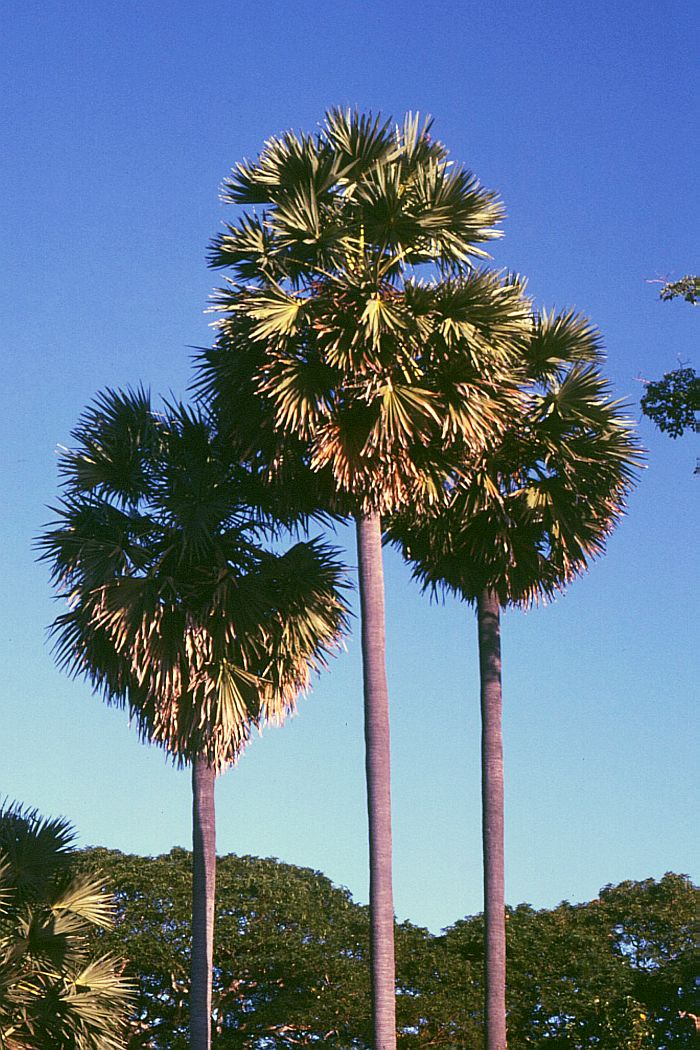- Borassus
image_caption = "Borassus flabellifer " inAngkor Wat , Cambodia
regnum =Plantae
unranked_divisio =Angiosperms
unranked_classis =Monocots
unranked_ordo =Commelinids
ordo =Arecales
familia =Arecaceae
subfamilia =Coryphoideae
tribus =Borasseae
genus = "Borassus"
genus_authority = L.Linnaeus, Species Plantarum 1187. 1753. Type:"B. flabellifer"]
subdivision_ranks = Species
subdivision = See text.|"Borassus" (Palmyra Palm) is a genus of six species of fan palms, native to tropical regions of
Africa ,Asia andNew Guinea . They are tall palms, capable of growing up to 30 m high. The leaves are long, fan-shaped, 2 to 3 m in length. Theflower s are small, in densely clustered spikes, followed by large, brown, roundish fruits.;Species
*"Borassus aethiopium " - African Palmyra Palm (and other names) (tropical Africa)
*"Borassus akeassii " - Ake Assi's Palmyra Palm (West Africa)
*"Borassus flabellifer " - Asian Palmyra Palm (and other names) (southern Asia and southeast Asia)
*"Borassus heineanus " - New Guinea Palmyra Palm (New Guinea)
*"Borassus madagascariensis " - Madagascar Palmyra Palm (Madagascar )
*"Borassus sambiranensis " - Sambirano Palmyra Palm (Madagascar)Cultivation and uses
Palmyra Palms are economically useful, and widely cultivated in tropical regions. The palmyra palm has long been one of the most important trees of
Cambodia andIndia , where it is used over 800 different ways. The leaves are used forthatch ing,mat s,basket s, fans,hat s,umbrella s, and aswriting material. InIndonesia the leaves of this plant are formerly used in the ancient culture as papers, known aslontar and also a Cambodian natural symbols tree that growing aroundAngkor Wat .Khmer call itTnaot . The sugar palm can live 100 year or more.Leaves of suitable size and shape and texture, with sufficient maturity are chosen. The leaves are then seasoned by boiling in salt water with
turmeric powder. This acts as apreservative .The leaves are then dried. When they are dry enough, the faces of the leaves are polished withpumice stone.Then they are cut in the proper size.
A hole is cut out in one corner. Each leaf will have four pages.
The writing is done with a stylus. The writing is of a very cursive and interconnected style.
The leaves are then tied up as sheaves.
The stalks are used to make fences and also produce a strong, wiry fiber suitable for cordage and brushes. The black
timber is hard, heavy, and durable and is highly valued forconstruction .The tree also yields many types of food. The young plants are cooked as a
vegetable or roasted and pounded to make meal. Thefruit s are eaten roasted or raw, and the young, jellylike seeds are eaten also. A sugary sap, called Toddy, can be obtained from the young inflorescence either male or female ones. Toddy is fermented to make a beverage calledarrack , or it is concentrated to a crude sugar called jaggery. It is called "Gula Jawa" (Java nese sugar) inIndonesia and is widely used in the Javanese cuisine. In addition, the tree sap is taken as alaxative , and medicinal values have been ascribed to other parts of the plant.This tree has a high respect in Tamil Culture. It is natural, then, to call it a "karpaha" or celestial tree, because all its parts without exception could be used by man.
In Tamil Nadu / Jaffna the seeds are planted and made to germinate and the fleshy stems (below the surface) are boiled and eaten. It is very fibrous and nutricious, known as "Panai Kizhangu" or "Panamkizhangu" in Tamil.The germinated seed's hard shell is also cut open to take out the crunchy kernel which tastes like a sweeter Water Chestnut. It is called "dhavanai" in Tamil. The Palmyra tree is the official tree of Tamil Nadu.
The riped fibrous outer layer of the palm fruits are also boiled / heated in fire and eaten.When the fruit is tender the kernel inside the hard shell called
Nungu Fruit in Tamil andThati Munjalu in Telugu is like a jelly and very delicious as well.When the crown of the tree is cut we get an edible cake from which the leaves grow out. This is called "Pananchoru" in Tamil.
Gallery of Borassus
References
reflist
External links
*http://www.pacsoa.org.au/palms/Borassus/index.html
*http://www.khemarinn.wordpress.com
*http://www.plantapalm.com/vpe/photos/Species/borassus_flabellifer.htm
*http://www.plantapalm.com/vpe/photos/Species/borassus_aethiopium.htm
*http://www.borassus-project.netee also
*
Sitala
Wikimedia Foundation. 2010.

